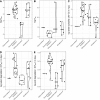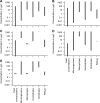Fungicides: An Overlooked Pesticide Class?
- PMID: 30835448
- PMCID: PMC6536136
- DOI: 10.1021/acs.est.8b04392
Fungicides: An Overlooked Pesticide Class?
Abstract
Fungicides are indispensable to global food security and their use is forecasted to intensify. Fungicides can reach aquatic ecosystems and occur in surface water bodies in agricultural catchments throughout the entire growing season due to their frequent, prophylactic application. However, in comparison to herbicides and insecticides, the exposure to and effects of fungicides have received less attention. We provide an overview of the risk of fungicides to aquatic ecosystems covering fungicide exposure (i.e., environmental fate, exposure modeling, and mitigation measures) as well as direct and indirect effects of fungicides on microorganisms, macrophytes, invertebrates, and vertebrates. We show that fungicides occur widely in aquatic systems, that the accuracy of predicted environmental concentrations is debatable, and that fungicide exposure can be effectively mitigated. We additionally demonstrate that fungicides can be highly toxic to a broad range of organisms and can pose a risk to aquatic biota. Finally, we outline central research gaps that currently challenge our ability to predict fungicide exposure and effects, promising research avenues, and shortcomings of the current environmental risk assessment for fungicides.
Conflict of interest statement
The authors declare no competing financial interest.
Figures





References
-
- Eurostat Pesticide sales. http://appsso.eurostat.ec.europa.eu/nui/show.do?dataset=aei_fm_salpest09.
-
- Roßberg D., NEPTUN 2009 - Weinbau. Berichte aus der BBA 2009, 151.
-
- Hakala K.; Hannukkala A. O.; Huusela-Veistola E.; Jalli M.; Peltonen-Sainio P. Pests and diseases in a changing climate: a major challenge for Finnish crop production. Agric. Food Sci. 2011, 20, 3–14. 10.2137/145960611795163042. - DOI
Publication types
MeSH terms
Substances
Grants and funding
LinkOut - more resources
Full Text Sources
Other Literature Sources
Medical

